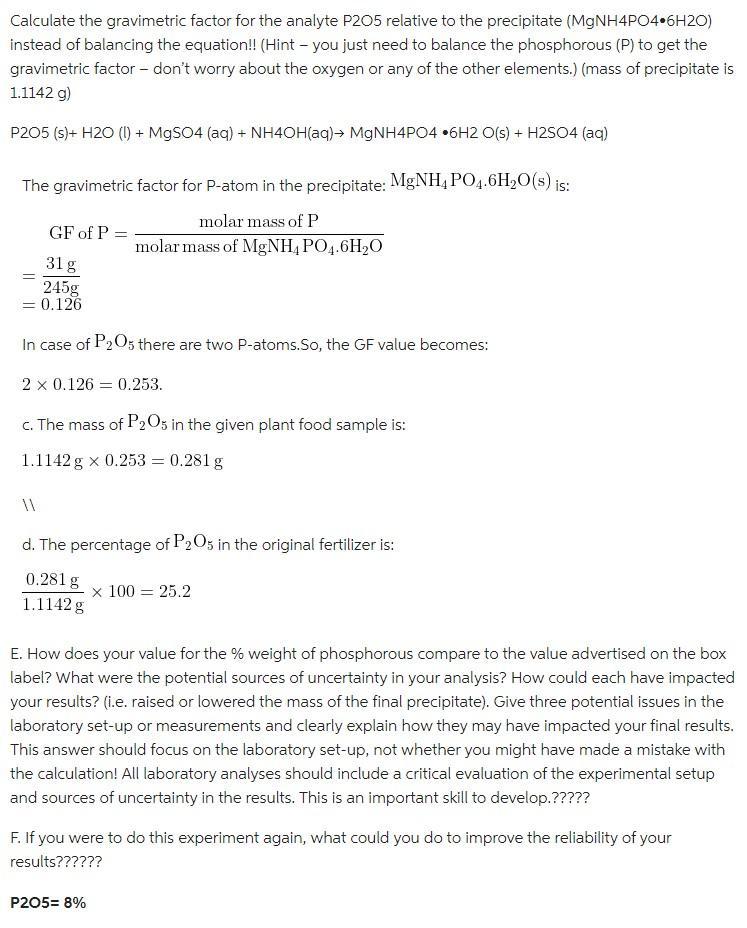Home /
Expert Answers /
Chemistry /
calculate-the-gravimetric-factor-for-the-analyte-mathrm-p-2-mathrm-o-5-relative-to-the-p-pa422
(Solved): Calculate the gravimetric factor for the analyte \( \mathrm{P} 2 \mathrm{O} 5 \) relative to the p ...
Calculate the gravimetric factor for the analyte \( \mathrm{P} 2 \mathrm{O} 5 \) relative to the precipitate \( (\mathrm{MgNH} 4 \mathrm{PO} 4 \bullet 6 \mathrm{H} 2 \mathrm{O}) \) instead of balancing the equation!! (Hint - you just need to balance the phosphorous (P) to get the gravimetric factor - don't worry about the oxygen or any of the other elements.) (mass of precipitate is \( 1.1142 \mathrm{~g}) \) \[ \mathrm{P} 2 \mathrm{O} 5(\mathrm{~s})+\mathrm{H} 2 \mathrm{O}(\mathrm{l})+\mathrm{MgSO} 4(\mathrm{aq})+\mathrm{NH} 4 \mathrm{OH}(\mathrm{aq}) \rightarrow \mathrm{MgNH} 4 \mathrm{PO} 4 \cdot 6 \mathrm{H} 2 \mathrm{O}(\mathrm{s})+\mathrm{H} 2 \mathrm{SO} 4(\mathrm{aq}) \] The gravimetric factor for P-atom in the precipitate: \( \mathrm{MgNH}_{4} \mathrm{PO}_{4} \cdot 6 \mathrm{H}_{2} \mathrm{O}( \) s \( ) \) is: \[ \begin{aligned} & \mathrm{GF} \text { of } \mathrm{P}=\frac{\text { molar mass of } \mathrm{P}}{\text { molar mass of } \mathrm{MgNH}_{4} \mathrm{PO}_{4} \cdot 6 \mathrm{H}_{2} \mathrm{O}} \\ =& \frac{31 \mathrm{~g}}{245 \mathrm{~g}} \\ =& 0.126 \end{aligned} \] In case of \( \mathrm{P}_{2} \mathrm{O}_{5} \) there are two \( \mathrm{P} \)-atoms.So, the GF value becomes: \[ 2 \times 0.126=0.253 \text {. } \] c. The mass of \( \mathrm{P}_{2} \mathrm{O}_{5} \) in the given plant food sample is: \( 1.1142 \mathrm{~g} \times 0.253=0.281 \mathrm{~g} \) 11 d. The percentage of \( \mathrm{P}_{2} \mathrm{O}_{5} \) in the original fertilizer is: \[ \frac{0.281 \mathrm{~g}}{1.1142 \mathrm{~g}} \times 100=25.2 \] E. How does your value for the \( \% \) weight of phosphorous compare to the value advertised on the box label? What were the potential sources of uncertainty in your analysis? How could each have impacted your results? (i.e. raised or lowered the mass of the final precipitate). Give three potential issues in the laboratory set-up or measurements and clearly explain how they may have impacted your final results. This answer should focus on the laboratory set-up, not whether you might have made a mistake with the calculation! All laboratory analyses should include a critical evaluation of the experimental setup and sources of uncertainty in the results. This is an important skill to develop.????? F. If you were to do this experiment again, what could you do to improve the reliability of your results?????? \[ \text { P2O5=8\% } \]
Expert Answer
I look at mistake in the chemical equation
